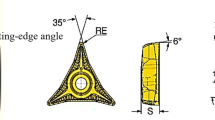Abstract
In this paper, the relationship between the cutting conditions and the wear mechanisms in turning Inconel718 from both modeling and experiment points of view has been studied. The tool chosen consists of a hard fine-grained WC with 6% Co with TiAlN layer. As a result, the recommended machining conditions with minimal wear would be the selection of a tool with a radius of 1.6 mm and the cutting velocity in the range of 45 to 55 m/min. The optimal variables obtained from artificial neural networks and genetic algorithm are found to be in good agreement with the results of laboratory findings on the wear mechanism map. Also, the results showed that at lower cutting velocities and feed rates, the TiAlN layer acts to prevent the transfer of elements between the tool and workpiece (mild and transient wear zones), causing the turning forces to stabilize over time. However, with an increase in the cutting velocity and feed rate (severe zone), the TiAlN layer breaks off the tool surface resulting in a considerable increase in the friction coefficient, cutting forces, and the adhesive wear. The main reason for this phenomenon is the transfer of elements such as nickel, chrome, and iron to the flank face.










Similar content being viewed by others
References
Balin S (2011) Non-identical parallel machine scheduling using genetic algorithm. Expert Syst Appl 38:6814
Biksa A, Yamamoto K, Dosbaeva G, Veldhuis SC, Fox-Rabinovich GS, Elfizy A (2010) Wear behavior of adaptive nano-multilayered AlTiN/MexN PVD coatings during machining of aerospace alloys. Tribol Int 43:1491
Childs T, Maekawa K, Obikawa T, Yamane Y (2000) Metal machining: theory and applications. Wiley, New York
Costes JP, Guillet Y, Poulachon G, Dessoly M (2007) Tool-life and wear mechanisms of CBN tools in machining of Inconel 718. Int J Mach Tools Manuf 47:1081
Dudzinski D, Devillez A, Moufki A, Larrouquère D, Zerrouki V, Vigneau J (2004) A review of developments towards dry and high speed machining of Inconel 718 alloy. Int J Mach Tools Manuf 44:439
Ezugwu EO (2005) Key improvements in the machining of difficult-to-cut aerospace superalloys. In J Mach Tools Manuf 45:1353
Hao Z, Gao D, Fan Y, Han R (2011) New observations on tool wear mechanism in dry machining Inconel718. Int J Mach Tools Manuf 51:973
ISO3685 (2003) Tool-life testing with single-point turning tools. Genève, International Organization for Standardization
Jianxin D, Lili L, Jianhua L, Jinlong Z, Xuefeng Y (2005) Failure mechanisms of TiB2 particle and SiC whisker reinforced Al2O3 ceramic cutting tools when machining nickel-based alloys. Int J Mach Tools Manuf 45:1393
Liao YS, Shiue RH (1996) Carbide tool wear mechanism in turning of Inconel 718 superalloy. Wear 193:16
Lim SC, Lim CYH (2001) Effective use of coated tools—the wear-map approach. Surf Coat Technol 139:127
Mazahery A, Ostad Shabani M (2012) Process conditions optimization in Al–Cu alloy matrix composites. Powder Technol 225:101
Mazahery A, Ostad Shabani M, Rahimipour MR, Razavi M (2012) The numerical modeling of abrasion resistance in casting aluminum–silicon alloy matrix composites. J Compos Mater 46:2647
Mokhtari Homami R, Fadaei Tehrani AR, Mirzadeh H, Movahedi B, Azimifar F (2014) Optimization of turning process using artificial intelligence technology. Int J Adv Manuf Technol 70:1205
Nalbant M, Altin A, Gökkaya H (2007) The effect of cutting speed and cutting tool geometry on machinability properties of nickel-base Inconel 718 super alloys. Mater Des 28:1334
Nath C, Rahman M, Neo KS (2009) A study on the effect of tool nose radius in ultrasonic elliptical vibration cutting of tungsten carbide. J Mater Process Technol 209:5830
Oliaei SNB, Karpat Y (2016) Investigating the influence of built-up edge on forces and surface roughness in micro scale orthogonal machining of titanium alloy Ti6Al4V. J Mater Process Technol 235:28
Oliveira VV, Beltrao PA, Pintaude G (2011) Effect of tool geometry on the wear of cemented carbide coated with TiAlN during drilling of compacted graphite iron. Wear 271:2561
Ozel T, Karpat Y (2005) Predictive modeling of surface roughness and tool wear in hard turning using regression and neural networks. Int J Mach Tools Manuf 45:467
Parida AK, Maity K (2017) Effect of nose radius on forces, and process parameters in hot machining of Inconel 718 using finite element analysis. Eng Sci Technol Int J 20:687
Sandvik Turning Inserts Catalog (2009) Sandvik Coromant, Heat resistant superalloys, pp 69
Singh GS, Singh J, Singh H, Singh R (2011) Investigation on wear behaviour of cryogenically treated TiAlN coated tungsten carbide inserts in turning. Int J Mach Tools Manuf 51:25
Thakur DG, Ramamoorthy B, Vijayaraghavan L (2009) Study on the machinability characteristics of superalloy Inconel 718 during high speed turning. Mater Des 30:1718
Tofigh AA, Ostad Shabani M (2013) Efficient optimum solution for high strength Al alloys matrix composites. Ceramics Int 39:7483
Ulutan D, Ozel T (2011) Machining induced surface integrity in titanium and nickel alloys: a review. Int J Mach Tools Manuf 51:250
Ulutan D, Ozel T (2013) Determination of tool friction in presence of flank wear and stress distribution based validation using finite element simulations in machining of titanium and nickel based alloys. J Mater Process Technol 213:2217
Author information
Authors and Affiliations
Corresponding author
Rights and permissions
About this article
Cite this article
Movahedi, B., Mokhtari Homami, R. & Akhavan, S. A New Approach of Wear Mechanism Map in Turning Inconel718 with PVD-Coated Inserts Using Advanced Techniques. Iran J Sci Technol Trans Mech Eng 44, 1091–1102 (2020). https://doi.org/10.1007/s40997-019-00308-w
Received:
Accepted:
Published:
Issue Date:
DOI: https://doi.org/10.1007/s40997-019-00308-w



